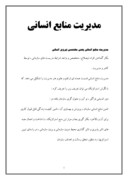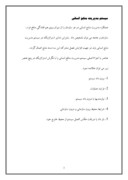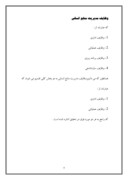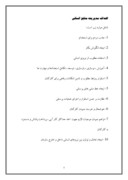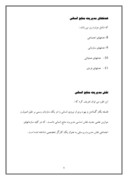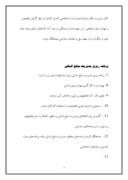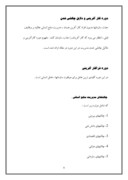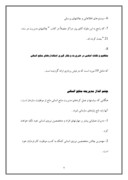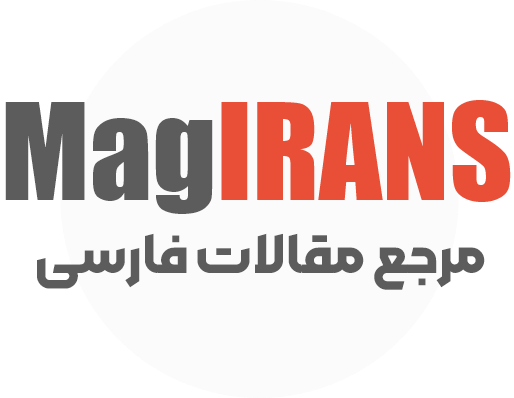بخشی از مقاله
مدیریت منابع انسانی
مدیریت منابع انسانی یعنی مهندسی نیروی انسانی
بکار گماشتن افراد ذیصلاح ، متخصص و واجد شرایط در پست های سازمانی ، توسط کادر و مدیریت .
مدیریت منابع انسانی قسمت عمده ای از قلم و علم و هنر مدیریت را تشکیل می دهد. که با نگرش استراتژیک می توان تعریف زیر را تعریف کرد :
دور اندیشی فراگیر ، نو آور و تحول گری سازمان یافته در :
تامین منابع انسانی سازمان ، پرورش و بهسازی آن ، تامین کیفیت
زندگی قابل قبول کاری برای آن و بالاخره بکار گیری بجا و موثر این منبع استراتژیک ، با شناخت و اعمال جنبه های تاثیر پذیری و تاثیر گذاری محیط درون سازمانی و برون سازمانی ، در راستای تبیین استراتژیها ، به منظور تحقق رسالت و اهداف سازمان
سیر تحول دانش مدیریت منابع انسانی
برای دانشجویان رشته مدیریت رویدادهای گذشته اهمیت خاصی دارد ، زیرا بررسی مسائل گذشته مفهوم واقعی مشکلات را روشن می سازد به همین جهت مختصری ا ز سیر تحول از دو دیدگاه متفاوت بررسی شده است که عبارتند از :
1- مدیریت منابع انسانی قبل از انقلاب صنعتی
2- مدیریت منابع انسانی بعد از انقلاب صنعتی
عوامل موثر بر شکل گیری مدیریت منابع انسانی
که به قرار زیر می باشد .
1- دوران نارضایی و بی ظرفیتی 1920-1980
2- پیشرفت مدیریت امور استخدامی در سالهای 1940-1920
3- شکل گیری دانش مدیریت منابع انسانی 1970-1950
3- تکامل دانش مدیریت منابع انسانی از 1970 به بعد .
سیستم مدیریت منابع انسانی
عملکرد مدیریت منابع انسانی در هر سازمان را از میزان روی هم افتادگی منافع فرد ، سازمان و جامعه می توان تشخیص داد . بنابراین تدابیر استراتژیک در سیستم م
دیریت منابع انسانی باید در جهت افزایش فصل مشترک این سه دسته منابع اعمال گردد .
عناصر یا اجزاء اصلی سیستم مدیریت منافع انسانی را با نگرش استراتژیک در پنج عنصر زیر می توان خلاصه نمود .
1- برون داد سیستم
2- فرایند عملیات
3- نیازمندیها یا درون داد سیستم
4- شرایط محیط برون سازمانی و درون سازمانی
5- باز داد یا دریافت عکس العمل سیستم از محیط خارج خود
وظایف مدیریت منابع انسانی
که عبارتند از :
1- وظایف اداری
2- وظایف عملیاتی
3- وظایف برنامه ریزی
4- وظایف سازماندهی
همانطور که می دانیم وظایف مدیریت منابع انسانی به دو بخش کلی تقسیم می شوند که عبارتند از :
1- وظایف اداری
2- وظایف عملیاتی
که راجع به هر دو مورد فوق در تحقیق اشاره شده است .
اهداف مدیریت منابع انسانی
شامل موارد زیر است :
1- جذب مردم برای استخدام
2- ایجاد انگیزش بکار
3- استفاده مطلوب از نیروی انسانی
4- آموزش ، نوسازی ، بازسازی ، توسعه ، تکامل استعدادها و مهارت ها
5- استقرار روابط مطلوب و تامین امکانات رفاهی برای کارکنان
5- ایجاد خط مشی های پرسنلی
6- نظارت بر حسن استقرار و اجرای عملیات پرسنلی
6- خوشحال و خرسند نمودن کارکنان
7- فراهم نمودن موجبات لازم جهت اخذ حداکثر کار آیی ، پرداخت پاداش و دستمزد به کارکنان
10 -ایجاد تعادل و توازن بین نیروهای انسانی داخل و خارج سازمان
هدفهای مدیریت منابع انسانی
که شامل موارد زیر می باشد :
8- هدفهای اجتماعی
9- هدفهای سازمانی
10- هدفهای عملیاتی
11- هدفهای فردی
نقش مدیریت منابع انسانی
این طور می توان تعریف کرد که :
فلسفه بکار گماشتن و بهره بری از نیروی انسانی را در یک سازمان رسمی بر طبق اصول و موازین علمی جدید نقش اساسی مدیریت منابع انسانی دانست . که در کلیه سازمانهای اجتماعی نقش مدیریت پرسنلی به عنوان یک کارگر تخصصی شناخته شده است .
کادر مدیریت یک سازمان عبارتست از اشخاصی که هر کدام با در نظر گرفتن تخصص و مهارت خود وظایفی را بر عهده دارند و همگی در صد آنند که فعالیت های واحد تابعه خود و دیگران را در جهت نیل به اهداف سازمانی هماهنگ سازند .
برنامه ریزی مدیریت منابع انسانی
7- برنامه ریزی مدیریت منابع انسانی برای سازمانها مزایای زیر را دارد :
8- بهبود در به کار گیری بهینه نیروی انسانی
9- تطبیق کار آمد فعالیتهای پرسنلی و اهداف آتی سازمان
10- دستیابی به صرفه جویی اقتصادی در استخدام کارکنان جدید
11- گسترش پایه اطلاعاتی مدیریت منابع انسانی به منظور کمک به سایر فعالیتهای پرسنلی و سایر واحدهای سازمانی
12- هماهنگ کردن برنامه های مختلف مدیریت منابع انسانی مانند برنامه های مثبت اجرایی و نیازهای استخدامی
13-
دوره کار آفرینی و دلایل چالشی شدن
حیات سازمانها مدیون افراد کار آفرین هستند ، مدیریت منابع انسانی
علاوه بر وظایف قبلی ، انتظار می رود که کار آفرینان را جذب سازمان کنند . مفهوم دوره کارآفرینی و دلایل چالشی شدن مدیریت در این دوره در مقاله ارائه شده است .
دوره فراکار آفرینی
در این دوره کلیدی ترین عامل برای موفقیت سازمانها ، عامل انسانی است .
چالشهای مدیریت منابع انسانی :
که شامل موارد زیر است :
1- چالشهای بیرونی
2- چالشهای دانش فنی
3- چالشهای اقتصادی
4- چالشهای دولتی
5- چالشهای سازمانی
6- سیستم های اطلاعاتی و چالشهای پرسنلی
7- که راجع به این مقوله آقای پیتر دراکر مفصلاً در کتاب " چالشهای مدیریت در سده 21 " بحث کرده اند .
8-
مفاهیم و نکات اساسی در ضرورت و بکار گیری استانداردهای منابع انسانی
که شامل 19 مورد است که در فیش برداری ارائه گردیده است .
چشم انداز مدیریت منابع انسانی
هنگامی که سیاستها و عمل کردهای مدیریت منابع انسانی مانع از موفقیتت سازمان است ، آنها باید تابع نیازهای سازمانی شوند .
1- مدیران عملیاتی بیشتر بر مهارتهای افراد و متخصصین نیروی انسانی خود تکیه خواهند کرد .
2- مهمترین چالش متخصصین نیروی انسانی کمک به کسب موفقیت کار فرمایان خود است .
نتیجه گیری از بحث مدیریت منابع انسانی
از آنجایی که کارکنان به عنوان سرمایه های اصلی سازمان در نظر گرفته می شوند ، ضروریست با اتخاذ و بکار گیری الگوهای مناسب باز ، مهندسی و سرمایه گذاری در منابع انسانی ، زمینه کیفیت بخشی فعالیت ها و ارائه خدمات مطلوب را فراهم نموده واز این طریق ضمن تاثیر گذاری کیفی بر روند عمر و چرخه سازمان می توان موجبات بهره وری و توسعه پایدار برای سازمان را پی ریزی کرد به این دلیل که اصولاً ریشه هر نوع تحول ، تغییر و توسعه از منابع انسانی شروع می گردد .
منابع و ماخذ
1- مدیریت استراتژیک منابع انسانی و روابط کار دکتر ناصر سیاسی – نشرمیر
2- مدیریت منابع انسانی و اداره امور استخدامی دکتر پرهیزکار – نشر دیدار
3- مدیریت منابع انسانی دکتر نسرین جزنی – نشرنی
سایت اینترنتی
Human research
www. Guickmba . com / marketing / research
Human research standrda
www, accel-tam . com / human – resources / hrm –ol. Htm1
Concept of Human Resource Management
The Human Resource Management Human Resources Engineering
They employ competent and qualified expert in organizational posts by Ka tion and management.
Human resource managemen
t is a major part of the pen and the management of science and art form. Strategic approach can be defined with the following definition:
Comprehensive foresight, innovation and development organization in Gary:
Human resources, training, and improving the quality of life accept it and work for it, and finally the effective use of strategic resources, the knowledge and the influence of and effectiveness of the organization, and the external, in line with explain strategies to achieve the organization's mission and goals
Evolution of Human Resource Management
Past Events management is particularly important for students because of the things that makes sense to clear the problem from slightly different perspectives of the evolution of the two are as follows:
1 - HRM before the Industrial Revolution
2 - Human Resource Management from the Industrial Revolution
Factors Shaping Human Resource Management
Which is as follows.
1 - r NAR convention and inefficiency during 1920-1980
2 - The development of administrative management in the years 1940-1920
3 - Formation of Human Resource Management 1970-1950
3 - Evolution of human resource management dimension 1970 .
Human Resource Management System
HRM function in the overlapping areas of the individual as a person, organization and community can be identified. Therefore measures the strategic human resource management system should be applied to improve the intersection of these three sources.
The main component as individual elements or human resource management system with a strategic approach ca
n be summarized in the following five elements.
1 - The output of the system
2 - Process Operations
3 - Classified within the system
4 - External environment and internal
5 - Open to or receive from outside their system response
Human resource management tasks
They are:
1 - Administrative tasks
2 - Operational tasks
3 - Scheduled tasks
4 - Organize tasks
As we know, human resource management functions are divided into two parts as follows:
1 - Administrative tasks
2 - Operational tasks
In both cases the research has been mentioned about.
Human resource management objectives
Include the following:
1 - Attract people to hire
2 - Motivating used
3 - Optimum use of manpower
4 - Education, rehabilitation, reconstruction, development, development of talents and skills.
5 - Establishment of good relations and provide amenities for employees
5 - Create personnel policies
6 - Supervising the establishment and operations personnel
6 - And happy employees make happy
7 - Provide grounds for obtaining maximum efficiency, bonuses and salaries paid to employees
10 - Creating a balance between human resources inside and outside the organization
The goals of human resource management
Include the following:
8 - Social goals
9 - Organizational goals
10 - Operational goals
11 - Individual goals
The Role of Human Resource Management
It can be defined as:
Philosophy and exploitation of manpower to engage in a formal organization in accordance with the principles of academic standards and new role as HR Manager. Personnel management role in all social organizations specialized workers known as a.
Team A cloak of the test persons, each taking their expertise and functions are responsible for all the activities of its subsidiaries are hundreds of others in order to achieve organization match formation.
Hu
man resource management planning
7 - Human resource management planning for the organization has the following advantages:
8 - Improve the efficiency in using manpower
9 - Efficient implementation of personnel activities and future goals of the organization
10 - Achieving economic efficiency in th
e recruitment of new staff
11 - Expanded data base management personnel and other resources to support the activities of other organizational units
12 - Coordinate various HR programs such as affirmative action programs and employment needs
13 -
Entrepreneurship courses and the reasons for the challenge
Organizations are entrepreneurs owe their existence, human resource management, in addition to the previous tasks, is expected to attract entrepreneurs to the organization. Concepts of entrepreneurship and the challenge for management is presented in the course.
Frakar of entrepreneurship
In this period, the most critical factor for success of enterprises, the human factor.
Challenges of Human Resource Management
Which include the following:
1 - External Challenges
2 - Technical challenges
3 - Economic Challenges
4 - Governmental Challenge
5 - Organizational challenges
6 - Information systems and personnel challenges
7 - Mr. Peter Drucker about this issue in detail in the book "Management Challenges for the 21st Century" have been discussed.
8 -
Concepts and fundamentals of HR in the necessity and use of standards
Which includes 19 items that taking notes is presented.
Human resource management perspective
When the functions of human resource management policies and impede the success of the organization, they should be subject to corporate needs.
1 - Most operations managers will rely on the skills and expertise of its workforce.
2 - The main challenges HR professionals to help their employers succeed.
The conclusion of the discussion of human resource management
Since employees are considered as the main investment is necessary to adopt and implement appropriate models open, engineering and investment in resources, staff, quality of work and the quality of services provided from through The qualitative influence on the cycle of life and can be optimized for efficiency and sustainable development organization established to This i
s basically the root cause of each type of change, change, and development of human resources begins.
Sources
1 - Strategic human resource management and labor relations, political N. doctor - Meyer Enquiry
2 - Human Resources Management and administrative ed RA doctor or virtuous - Meet the Press
3 - HRM doctor she Jazani - Nshrny
Website
Human research
www. Guickmba. com / marketing / research
Human research standrda
www, accel-tam. com / human - resources / hrm-ol. Htm1

